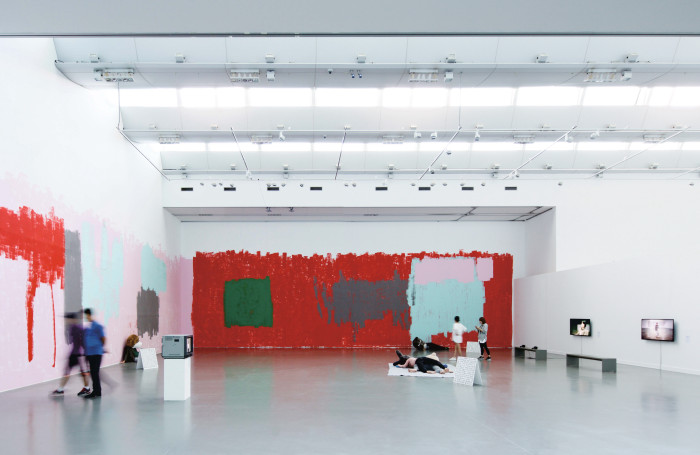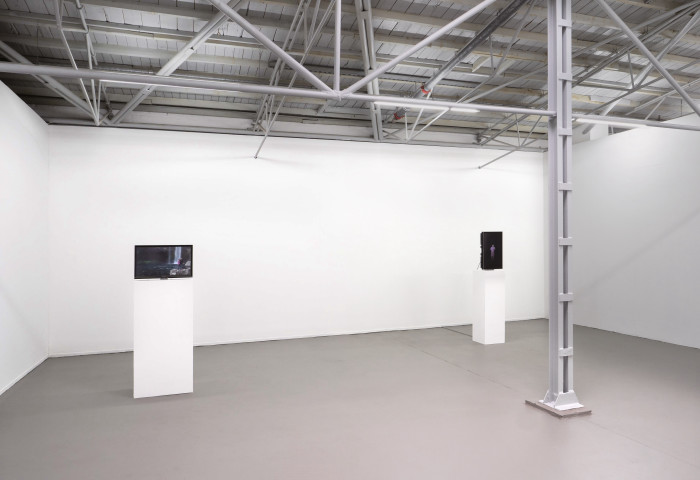경기문화재단
Facing a Big Wall by Gimhongsok
Gyeonggi Museum of Modern art
This catalogue is published in conjunction with 2017-2018 Korea–Germany Contemporary Art Exchange Exhibition Irony & Idealism. It documents all exhibitions and artworks at 3 venues in Korea and Germany-Gyeonggi Museum of Modern Art, KF Gallery and Kunsthalle Münster-from September 2017 until September 2018.
|
Choi Heeseung Curator, National Museum of Modern and
Contemporary Art, Korea
Gimhongsok has displayed the communications,
systems, and ethical borders revealed in the process
of producing and exhibiting his works of art. At the
exhibition Irony and Idealism, he introduced six artistic
projects, including new pieces. It is not easy to
demonstrate an individual artist’s artistic world in a
group exhibition. However, Gimhongsok effectively
organized his representative works for this exhibition
to show the direction of his oeuvre. Illustrating
a unique formal language for each genre, his sculptures,
paintings, videos, and installations occupied
the given space as if establishing another show
within the exhibition.
Seemingly solid but never edged, Gimhongsok’s
artistic projects approach viewers in a friendly way
but require sufficient time and will to be appreciated.
Like documentary pieces, his works of art are
able to be understood only through a close examination
of the artist’s intention, production processes,
and small details within the frame. It is not easy
to address his artistic vision in a limited space, so
I would like to pursue my own purpose here and
discuss some hidden features found in his projects
exhibited at Irony and Idealism.

Entering the gallery space, our eyes and bodies are overwhelmed by a wall filled with colors. At the entrance, we are struck by a red surface and then, the pink, green, and grey portions of the wall appear. Featuring a large-scale color-filled painting, Untitled (A Big Wall) (2017) reminds us of “Gimhongsok’s zone” in the gallery space. What is notable here is that the viewers’ vision is unconsciously captivated by an impression of the large red wall. The red is clearly in the scarlet range of the palette while still delivering a cold-hearted feeling. At the edge of the evenly painted wall, we can see some large brushstrokes. Though the brushed edge seems to be most extempore, it delivers a neat and measured feeling. In this way, one of the elements characterizing Gimhongsok’s works of art is a cool sensation delivered through hot visual language.

In front of Untitled (A Big Wall), four mannequins
are laid out or tangled on the floor for the project
Solitude of Silence (in Korea) (2017). The mannequins
are wearing their doll mask, and each of them
takes on a certain role including a driver, student,
and dancer. However, their poses or gestures demonstrate
their disinterest in their roles. Beside each
mannequin, there is a signboard that catches the
viewers’ attention. Only for these moments while
the viewers try to judge the veracity of the text on
the sign board—whether the text is real or not—can
the hollow mannequins fulfill their responsibilities
as laborers (whether their labor means their character’s
role play described on the sign board or their
presence as an element in the work.)

Facing Untitled (A Big Wall), another project, People Objective-Of Ordinary Art (Video A, Video B) (2011) is displayed. Distinct from the previous works easily captured through intuition, this project is layered with numerous different meanings. Completed via co-working with five actors, People Objective-Of Ordinary Art deals with the relationship between the artist’s labor (during production) and the capital (as his reward), as well as the viewers’ unique position for perceiving such a co-working project.
In a sense, one of Gimhongsok’s major achievements is to point out labor as an important issue in the field of art. The labor that he describes in his projects is mainly based on something that occurred in the process of producing or delivering the works of art. His description is expressed through a sorrowful yet gracious language that leaves us both cheerful and depressed. For People Objective-Of Ordinary Art, all of the elements—the actors on the screen, the artist who provides direction to them, and the reward that the actors earn through their participation in art—are precisely written in the text in a refined manner. In Gimhongsok’s works, text also plays an important role. By employing text from a specific source or writing by himself, he visualizes a systemic relationship between the artist, participators, and the viewers.

Considering the artistic projects that I discussed here, the viewer should be defined within a wider range for Gimhongsok, who discusses the “public,” compared to with other artists. Nevertheless, his artistic projects point to various aesthetic values rather than being categorized as a public-friendly work. This is perhaps because he considers art itself to be a starting point and a material for his works. Moreover, his artistic projects pursue communication while focusing on individual voices—this helps the viewers to face diversity as if allowing them to stand in front of a big red wall.
In conclusion, Gimhongsok’s works reveal for viewers the process and structure in which contemporary art is produced and obtains authority. His works of art achieve the authority of art by locating a counter-question about such authority. He points to somewhat fundamental questions that we cannot clearly address including where does an authority of art stem from? In what ways, can we calculate the reward for a collaborative work between an artist and co-workers? What are the criteria for differentiating art from non-art? Gimhongsok’s big wall seems to speak to his role as an artist—it is to continuously ask questions for viewers and leave them wondering and imagining what is behind the wall.

<ggc의 모든 콘텐츠는 저작권법의 보호를 받습니다.>
세부정보
IRONY & IDEALISM
Publisher/ Sul Wonki
Chief Editor/ Choi Eunju
First Edition/ July 31. 2018
Published by/ Gyeonggi Museum of Modern Art
List of Artists/ Ahn Jisan, Bae Young-whan, Björn Dahlem, Gimhongsok, Hwayeon Nam, Michael van Ofen, Manfred Pernice, Yoon Jongsuk
#태그
@참여자
-
,
지지씨가 권하는 글
경기문화재단, 인천국제공항공사와 공공예술 협력사업 ‘홍범 《기억의 정원》’ 전시 선보여
경기문화재단 × 인천국제공항공사 공공예술 협력사업 네 번째 전시
주민 해설사와 함께하는 파주 해마루촌〈DMZ 산보〉프로그램 개최
〈DMZ 산보〉프로그램, 2025년 10월 11일부터 12월 13일까지 매주 토요일 진행
경기상상캠퍼스에서 만나는 판화와 디자인의 즐거움〈나만의 아트 프린트〉수강생 모집
‘어린이’와 ‘청소년 및 성인’ 대상으로 11~12월 총 2개 교육 프로그램 진행
경기 12 잡가 PROJECT <傳歌 : 노래를 전하다>
모든예술31 선정작